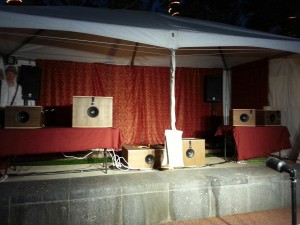In 1913 a group of Italian Futurists proposed a bold treatise, that noises (of all types) deserve to be included in the musical lexicon as equals to their instrumental equivalents. With that being said, Luigi Russolo and Francesco Balilla Pratella decided to take this a step further and create quasi-instruments or rather Intonarumori to produce a bricolage of sounds and colors. He created categories of noises that certain types of sounds would fall. This could include things like buzzes, growls, voices, rumbles, among others.
Since 1913, there have many efforts to revive the old versions of the now extinct Intonarumori. This year, urbanSTEW, decide to re-imagine this movement 100 years later. This was in part a commission by the Mesa Arts Center for their spark! Festival in March, 2013. However, instead of building mechanical versions, a strength that I do not have, we built digital versions with physical interfaces. I was the head of sound design which includes the speaker/hardware interface, audio programming on the Rpi and linux scripting.
More video and other media is available: http://urbanstew.org/projects/intonarumori-noise-machines/
UPDATE: urbanSTEW’s Intonarumori Project was selected as the Grand Prize Winner in the MAKE Magazine Raspberry Pi contest!
We built six boxes in total to somewhat correspond with Russolo’s six categories of noise. Our versions include:
1) Theremin Box (uses a modified Theremin, and Atari joystick)
2) Water Box (Jug of water, hydrophone and bellow)
3) Bike Box (Modified bike, buttons and samples)
4) Bass Box (A rubber string, and flight simulation throttle)
5) IR Drum Box (Infra-red sensors, and samples)
6) Blender Box (Blender parts)
Each box was equipped with a Raspberry Pi, a small 700Mhz microcomputer that uses a version of Debian Linux. On this Pi we were able to run Pure Data and create customized sound designs. To interface with the various controllers we used the Arduino micro controller. Each instrument had a small 40W amplifier and a 40W full range speaker that was attached to a Behringer UCG102. The Intonarumori were designed to be standalone instruments, essentially all they need is to be plugged in. This series of equipment gave us the most affordable and effective option for such a goal.
The various synthesis algorithms and/or digital signal processing employed to created the unique sounds of the boxes are as follows:
1) Theremin Box – Four distinct timbres that emulate 80s arcade sounds. For this I used square waves, sawtooth waves and a tricky little additive synthesis algorithm for the classic Mario jump.
2) Water Box – Uses a hydrophone input which is then passed through a custom comb filter, reverb, and ring modulation.
3) Bike Box – plays back a sample at a variable speed using a bicycle pedal and wheel unit. The wheel turns a DC motor which outputs a continuous voltage that is read by the computer.
4) Bass Box – The bass sound uses a series of Phase Aligned Format generators or PAF. These are meant to give the bass a not-so but oh-so quality to Peter Framton’s Framtone. It’s really nothing like a Framtone, but has a distinct vocal quality. The levers of the throttle change settings on a comb filter, variable delay and the frequency. We use the string as an envelope follower.
5) IR Drum Box – is based on a late 80s sampler. We have four drum samples (hi-hat, snare, tom, bass) which are then pitch shifted the old fashioned way, like a tape player, based on what the IR sensors read.
6) Blender Box – sometimes referred to as the Magic Blender. For this I used a series of off-tuned triangle waves with a distinct “wobble” for that variable speed blender behavior. Then this chord is passed through a series of variable delays which created fantastic artifacts.
